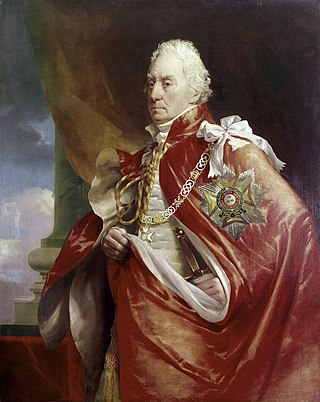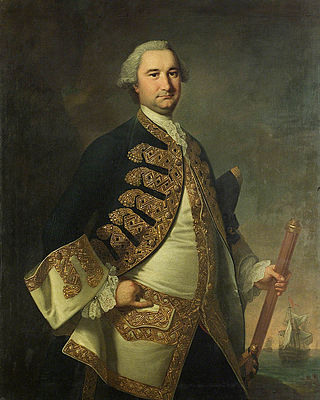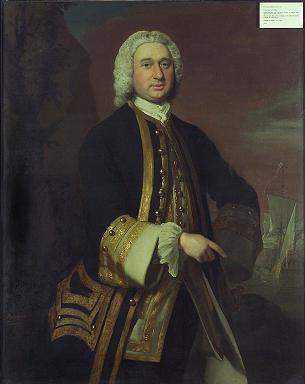
George Keith Elphinstone, 1st Viscount Keith, was a British naval officer active throughout the Napoleonic Wars.

Admiral Sir Charles Saunders was a Royal Navy officer. He commanded the fourth-rate HMS Gloucester and led her in action at the Second Battle of Cape Finisterre in October 1747 during the War of the Austrian Succession. After serving as Commander-in-Chief, Mediterranean Fleet, he was appointed Commander-in-Chief, English Channel in charge of the Western Squadron between October 1758 and May 1759). He took command of the fleet tasked with carrying James Wolfe to Quebec in January 1759 and consolidated the dead general's victory after the Battle of the Plains of Abraham in September 1759 by devoting great energy to keeping the British Army, now under the command of Colonel George Townshend, well supplied during the Seven Years' War. He later became Senior Naval Lord and then First Lord of the Admiralty.

The Commander-in-Chief, The Nore, was an operational commander of the Royal Navy. His subordinate units, establishments, and staff were sometimes informally known as the Nore Station or Nore Command. The Nore is a sandbank at the mouth of the Thames Estuary and River Medway.

Captain Archibald Kennedy, 11th Earl of Cassilis was a Scottish peer who lived in the English colony of New York which became part of the United States.

Admiral of the Fleet Sir Chaloner Ogle KB was a Royal Navy officer and politician. After serving as a junior officer during the Nine Years' War, a ship he was commanding was captured by three French ships off Ostend in July 1706 in an action during the War of the Spanish Succession.
Vice-Admiral Sir Peter Denis, 1st Baronet was an English naval officer and Member of Parliament.

Rear-Admiral Richard Tyrell was an Irish officer in the Royal Navy.

Admiral Sir Thomas Pasley, 1st Baronet was a senior and highly experienced British Royal Navy officer of the eighteenth century, who served with distinction at numerous actions of the Seven Years' War, American Revolutionary War and French Revolutionary Wars. In his youth he was renowned as an efficient and able frigate officer and in later life became a highly respected squadron commander in the Channel Fleet. It was during the latter service when he was awarded his baronetcy after losing a leg at the Glorious First of June, aged 60.

Admiral of the Fleet John Forbes, styled The Honourable from 1734, was a Royal Navy officer. After taking part in an expedition to Lisbon to support the Portuguese in the face of a Spanish threat, he saw action as captain of the third-rate HMS Norfolk at the Battle of Toulon during the War of the Austrian Succession. He was one of the few captains who really bore down on the enemy.
HMS Chichester was a 70-gun third rate ship of the line of the Royal Navy, designed by Sir Joseph Allin and built by Peirson Lock at Portsmouth Dockyard to the standard draught for 70-gun ships as specified in the 1745 Establishment amended in 1750, and launched on 4 June 1753.
Admiral Sir Edward Durnford King KCH was a Royal Navy officer. After taking part in the Glorious First of June he saw action at the blockade of Cadiz before going on to be Commander-in-Chief, Cape of Good Hope and Brazil in 1840 and then Commander-in-Chief, The Nore in 1845.

Admiral Sir Henry Edwyn Stanhope, 1st Baronet was a Royal Navy officer who became Commander-in-Chief, The Nore.

Admiral Charles Buckner was a Royal Navy officer who became Commander-in-Chief, The Nore. He was the brother of John Buckner, Bishop of Chichester, and grandfather of portraitist Richard Buckner.
Rear-Admiral Christopher Hill was a Royal Navy officer who served as Commander-in-Chief, River Medway and the Nore. Having joined the Royal Navy in 1731, Hill served off Ireland, Portugal, and in the Mediterranean Sea before being promoted to commander in 1746. After several commands he was then promoted to post-captain in 1747. While commanding HMS Dover he then captured the French East Indiaman Pondichéry during the Seven Years' War. Hill was on half pay between 1760 and 1769, then being given command of HMS Augusta and serving as Commander-in-Chief, River Medway and the Nore for the following year. His last command was HMS Barfleur towards the end of the year. A well thought of officer, Hill was promoted to rear-admiral in January 1778 but was killed in a fall from his horse six months later.

Rear Admiral William Gordon was a Royal Navy officer who became Commander-in-Chief, The Nore.

Admiral Matthew Buckle was a Royal Navy officer who served as Commander-in-Chief, the Downs from 1778 to 1779.

Rear Admiral Sir Digby Dent (1739–1817) was a late 18th century and early 19th century Royal Navy commander.
Raby Vane was a Royal Navy officer and Member of Parliament, a younger son of Henry Vane, 1st Earl of Darlington.
Captain Sir Richard Hughes, 1st Baronet was a Royal Navy officer of the eighteenth century who served as Resident Commissioner of Portsmouth Dockyard. Hughes joined the navy in 1721 and served on a variety of ships, some commanded by his father Captain Richard Hughes, mostly in the Mediterranean Sea and Baltic Sea, and was also a some-time follower of Admiral Sir John Norris. He was promoted to commander in 1739 and given command of HMS Anne Galley, and was promoted to post-captain in the following year. Having served mostly in command of ships in the Mediterranean Fleet, Hughes was given command of the guardship HMS Fougueux in 1753, from where he was appointed Resident Commissioner of Portsmouth in 1754. He served there until 1773, in which year he was created a baronet and then retired. He died at Southampton, aged 71.
Vice-Admiral George Mackenzie was a Royal Navy officer who served as Commander-in-Chief, The Nore from 1774 to 1775.










